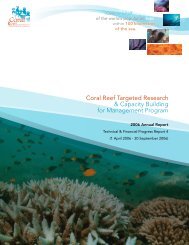Pulse Amplitude Modulation Fluorometry - Coral Reef Targeted ...
Pulse Amplitude Modulation Fluorometry - Coral Reef Targeted ...
Pulse Amplitude Modulation Fluorometry - Coral Reef Targeted ...
Create successful ePaper yourself
Turn your PDF publications into a flip-book with our unique Google optimized e-Paper software.
Seasonal fluctuations in the physiology ofStylophora pistillataGidon Winters 1 , Sven Beer 1* and Yossi Loya 21 Department of Plant Sciences, Tel Aviv University, Tel Aviv 69978, Israel;Department of Zoology, Tel Aviv University, Tel Aviv 69978, IsraelSeasonal fluctuations in the maximal quantum yield of photosynthetic electron flowthrough photosystem II (F v /F m ) as measured in situ were found to occur naturally inzooxanthellae of non-bleaching colonies of the branching coral Stylophora pistillatagrowing at 5, 10 and 20m. These fluctuations correlated stronger with changes inirradiance than changes in seawater temperature. Seasonal fluctuations were alsofound in the chlorophyll a density, which was due mostly to seasonal changes inzooxanthellae density. Results show that during the summer of a “non-bleachingyear”, corals will loose 80% of their zooxanthellae (in comparison with zooxanthellaedensities measured during the winter) the equivalent of zooxanthellae loss measuredin the Caribbean during the 1998 mass bleaching event (Warner et al. 2002).Underwater photographs taken monthly reveal the dramatic colour changes corals gothrough even during “non-bleaching” years. These results shed some light on theissue of what is “real” bleaching as apposed to seasonal changes. Possibly, what istermed mass bleaching should be seen as taking this normal (seasonal) paling ofcoral colour one notch forwards. For future PAM fluorometry based studies, it issuggested that, in order to correlate F v /F m values with anthropologically causedstresses, (a) F v /F m measurements be performed in situ under natural conditions and(b) natural seasonal fluctuations in F v /F m be taken into account when using thisparameter for diagnosing coral bleaching. It is further suggested that high irradiancesmay cause decreased F v /F m values at least as much as, if not more than, hightemperatures.FiguresFig.1. a) Study site and b) experimental set up: Specially made plastic holder for theDiving-PAM’s probe, allowing for repetitive measurements to be performed keepingthe same angle (69o) and distance (1 cm) between the sample and the PAM’s probe32








